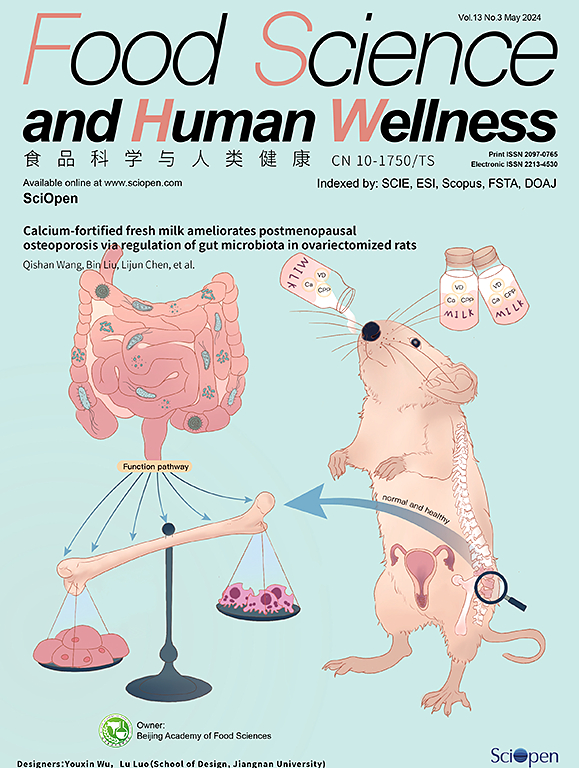四甲基吡嗪和芍药苷复方制剂(TMP-PF)通过 NR4A1/VEGFR2 途径降低高脂血症并抑制斑块血管生成,从而缓解动脉粥样硬化的进展
IF 7.4
1区 农林科学
Q1 FOOD SCIENCE & TECHNOLOGY
引用次数: 0
摘要
动脉粥样硬化仍然是全球人类健康的一大威胁。以往的研究发现,四甲基吡嗪(TMP)和芍药苷(PF)复方制剂(TMP-PF)在体外具有抗动脉粥样硬化的作用。然而,TMP-PF 是否能改善体内动脉粥样硬化还需要进一步探讨。本研究旨在评估 TMP-PF 在载脂蛋白E-/-小鼠体内的抗动脉粥样硬化特性,并探讨相关分子机制。结果显示,TMP和大剂量TMP-PF可降低载脂蛋白E-/-小鼠血清甘油三酯和低密度脂蛋白胆固醇水平,抑制血管内皮生长因子受体2(VEGFR2)和核受体亚家族4 A组1(NR4A1)在主动脉组织中的表达,抑制斑块血管生成,减少斑块面积,缓解动脉粥样硬化。此外,TMP-PF 比单独使用 TMP 或 PF 有更好的调节作用。然而,NR4A1激动剂会取消TMP-PF的抗动脉粥样硬化作用。总之,首次发现TMP-PF可通过NR4A1/VEGFR2途径降低高脂血症和抑制斑块血管生成,从而缓解动脉粥样硬化的进展,表明TMP-PF对降低高脂血症和减轻动脉粥样硬化的发展有积极作用。本文章由计算机程序翻译,如有差异,请以英文原文为准。
Tetramethylpyrazine and paeoniflorin combination (TMP-PF) alleviates atherosclerosis progress by reducing hyperlipemia and inhibiting plaque angiogenesis via the NR4A1/VEGFR2 pathway
Atherosclerosis remains a great threat to human health worldwide. Previous studies found that tetramethylpyrazine (TMP) and paeoniflorin (PF) combination (TMP-PF) exerts anti-atherosclerotic effects in vitro. However, whether TMP-PF improves atherosclerosis in vivo needs further exploration. The present study aims to assess the anti-atherosclerotic properties of TMP-PF in ApoE-/- mice and explore the related molecule mechanisms. Results showed that TMP and high-dose TMP-PF decreased serum triglyceride and low-density lipoprotein cholesterol levels, suppressed vascular endothelial growth factor receptor 2 (VEGFR2) and nuclear receptor subfamily 4 group A member 1 (NR4A1) expression in aortic tissues, inhibited plaque angiogenesis, reduced plaque areas, and alleviated atherosclerosis in ApoE-/- mice. Also, TMP-PF exhibited a better modulation effect than TMP or PF alone. However, NR4A1 agonist abolished the anti-atherosclerotic effects of TMP-PF. In conclusion, TMP-PF was first found to alleviate atherosclerosis progression by reducing hyperlipemia and inhibiting plaque angiogenesis via the NR4A1/VEGFR2 pathway, indicating that TMP-PF had a positive effect on reducing hyperlipemia and attenuating atherosclerosis development.
求助全文
通过发布文献求助,成功后即可免费获取论文全文。
去求助
来源期刊

Food Science and Human Wellness
Agricultural and Biological Sciences-Food Science
CiteScore
8.30
自引率
5.70%
发文量
80
审稿时长
28 days
期刊介绍:
Food Science and Human Wellness is an international peer-reviewed journal that provides a forum for the dissemination of the latest scientific results in food science, nutriology, immunology and cross-field research. Articles must present information that is novel, has high impact and interest, and is of high scientific quality. By their effort, it has been developed to promote the public awareness on diet, advocate healthy diet, reduce the harm caused by unreasonable dietary habit, and directs healthy food development for food industrial producers.
 求助内容:
求助内容: 应助结果提醒方式:
应助结果提醒方式:


